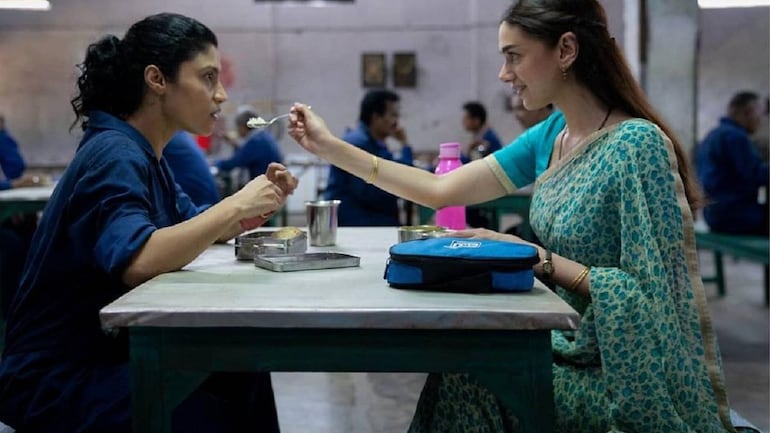How does one comprehend the messiness of feelings while watching Geeli Pucchi, the short from the Netflix anthology Ajeeb Dastaan, that attempts to unravel intersectionalities of caste, sexuality, power, and privilege. And while at it, it doesn’t shy away from portraying women characters who make questionable moral choices, though the contextualisation of their intent and action eventually makes it difficult to hold them accountable on moral grounds. The story is elusive in its depiction of the vulnerability of queerness and caste, it breaks the monotony of ‘aspirational heroines’, it wistfully taps on desire — desire of both kinds, of love and dignity.
The comprehension of messy feelings seems more complex when someone sees the story from inside the caste-sexuality marginalisation. Being a Dalit-Queer person myself, it’s difficult to let go of the oblivious representation of the people which it promises to empathise with. It fails to meet the mark as it again casts an upper-class cis-het actor for a queer-Dalit role, reinforces the ‘butch lesbian’ stereotypes, it constantly perpetuates the trope to the audience that the Dalit protagonist is meritorious and hence deserves dignity.
But this also brings the opportunity to reflect on whether it is truly possible to bring the authenticity of a marginalised character on the screen with honest research, educating oneself about the lived realities of marginalised people, as vouched by the actor and director in their multiple interviews. One can also ponder upon if the reinforcement of the ‘butch lesbian’ stereotype is caricaturist or the ambiguity of gender expression of the person adds value to the enormity of queerness.
Geeli Pucchi fails to meet the mark as it again casts an upper-class cis-het actor for a queer-Dalit role, reinforces the ‘butch lesbian’ stereotypes, it constantly perpetuates the trope to the audience that the Dalit protagonist is meritorious and hence deserves dignity.
Here lies the merit in the writing and vision of Geeli Pucchi director Neeraj Ghaywan, because a story doesn’t need to be ideal, it should ignite discussion about issues that have been historically and systematically brushed under the carpet.
Geeli Pucchi is a story of two people. Bharti, played by the exceptional Konkona Sen Sharma and Priya, played by Aditi Rao Hydari. Bharti is a machine operator at a factory who is joined by Priya, a soft-spoken, naïve newcomer on campus. At the beginning of the story itself, it is established that Bharti’s Dalit identity plays the major roadblock in achieving her desired desk job as a data operator. On the other hand, Priya, who is upper caste ‘Sharmaji ki Bahu’, exercises and enjoys her privileges with complete naivety.
In their first introduction when Priya asked Bharti’s surname, she replied Bharti Banarjee instead of Mandol. The few seconds of pause before Bharti’s response succeeds in capturing the tremendous burden of anxiety of consequences, rejection, judgment, that marginalised people constantly battle with. Masking has historically been a mechanism to fit in the mainstream.
With time, as the two grow intimately close, Bharti struggles to separate her feelings of fondness towards Priya and anger towards her casual caste-blindness. The coexistence of romantic intimacy and envy is often so tangled that it is almost impossible to gauge the overlaps of Bharti’s feelings. She knows Priya is probably not the reason for her marginalisation, but she also realises how Priya is a perpetrator of the same system that perpetuates casteism. Bharti’s feelings transcend between anger, helplessness, revenge, and most importantly vulnerability.

We don’t talk enough about vulnerability and marginalization.
In one scene Bharti fondly looks at the video of her ex-lover as tears roll down her cheeks, her body tightens in anguish. The frame zooms out capturing the void of the room. Bharti knows where she can afford to be vulnerable. When she is alone.
In the following scene, Bharti and Priya loiter around a park as they talk about friendship, childhood and engage in soft romantic teasing. When Bharti asks Priya about her job interview, she naively narrates the story. Bharti realises all her skills and hard work meant nothing just because of her caste position, whereas a mere palm reading got Priya the job. She couldn’t help but burst into tears. Yet, she was mindful of not completely giving in to her vulnerability in front of Priya.
Also read: 5 Dalit Artists Challenging Casteism Through Music, Films And Literature
The popular notions around marginalisation are either erasure of marginalised people’s lived experiences or asking them to ‘own their marginalisation’. Cribbing (read vulnerability) doesn’t get you anything. Vulnerability is established as bleak. This is also the politics of upper caste people of getting rid of accountability.
Vulnerability of marginalised people is often discomforting for them as that’s a reminder of their contribution to the caste systems and also their imagination of ‘being someone else’s shoe’ confines within their caste-class-gender privilege which fails to capture the struggle and labor of marginalised people who shift socio-economic-class positions. That’s why it is easy for them to disregard it. And that is how marginalised people are tutored in hiding their vulnerability. But their vulnerability is as much as a reality, as the sun rising from the east every morning.
Fortunately, Geeli Pucchi didn’t make a hero out of Bharti’s marginalisation but presented her with utmost authenticity, vulnerability, and morally conflicted choices. Bharti represents reality and not aspiration.
But the story couldn’t get away from the age-old trope of convincing the audience that marginalised people have to be exceptional to achieve their heart’s desire. The concurrent reiteration of how Bharti is an amazing worker, she is sharp, she does the same job in 20 minutes that Priya takes 2 hours, that she scored 74% in B.Com is somehow feels like a dire attempt to establish that you only deserve equality if you offer more than what is asked from you. If you are marginalised your over-achievements are the only marker of your credibility.
Thankfully, Geeli Pucchi moves past this and also addresses things that are exceptional on many fronts, most importantly the interaction of caste and queerness. Bharti and Priya both explore their mutual admiration for each other, but the way they experience their sexuality is different. That reflects how one’s queerness is shaped by their caste and caste is influenced by their queerness.
Bharti never comes out vehemently as a queer person to Priya, but she comes out as a Dalit person to her. Coming out itself is very political in nature that presupposes that there’s a secret that needs another person’s consideration, it needs acceptance. Here, Bharti knew that probably her queerness doesn’t need acceptance from Priya, but her caste does. The coming out is followed by Priya’s discomfort around Bharti. Though their queerness binds them together, their caste difference distances them.

And here comes out the bitter truth, ‘Your marginalisation doesn’t make you automatically sensitive to other forms of marginalisations.’ Often queer spaces aren’t completely accepting of Dalit identities and often Dalit spaces aren’t completely accepting of queer identities. Interestingly, in many contexts having the access to the vocabulary to queerness, having access to the understanding of pronouns, indicates the class privilege it brings with it. Being queer often can make a person part of upper-class spaces that would have otherwise been impossible if the identity of the person is the only Dalit.
In Geeli Pucchi, the absence of any dominant narrative around queerness at least allows looking at it whimsically, whereas the existent prejudiced narrative on caste is inescapable. It seems like it’s easier to ignore Bharti’s queerness but her caste is on the face. The moment you know the surname of the person, you are no more closeted. At times like this, even the agency of coming out appears as a privilege. Bharti is at the receiving end of casteist, hetero-patriarchal oppression.
Also read: 4 South Indian Movies That Start A Conversation About Caste
On the other hand, though Priya has caste privilege, she is also the victim of hetero-patriarchy. In the end, is it possible to villainise either of them? Is it possible to identify what identity liberates you and what identity chains you? Is it subjective or universal for all? Did Bharti give up on love and choose dignity? Are love and dignity mutually exclusive?
Geeli Pucchi leaves you with many questions and many feelings.
I have been part of many spaces that celebrate queerness, expresses honest fascination about it, whereas engaging in conversations around Dalit identity is often discomforting. Films like Geeli Pucchi are one of those rare opportunities where one can engage with stories that are close to home and heart.
As much as I can’t let go of the discomfort of not seeing a Dalit person portraying Bharti’s character, I also don’t want to let go of the joy of seeing a character on screen that tells our story, shares the same vulnerability as we do, whose feelings aren’t aspirational but inspirational, who retaliates with authenticity and not idealism. Geeli Pucchi makes you feel many things. The feelings are messy but I am also learning to make peace with the messiness of caste and queerness.
Featured Image Source: a still from Geeli Pucchi
About the author(s)
Sudipta Das(He/They) is a communications professional having experience of working on issues around gender-based violence, child rights, queer rights and sexuality. They have been an India Fellow'17 and a Likho Citizen Journalism Fellow'19. They believe in intersectional feminism and wish to write elaborately on the subjects of media, caste, sexuality and mental health.





Summary : Fantasy exaggeration by a degenerate.
Based !
highly agree on the trope of achievement warranting dignity in this story. It left an impression on me. Very powerful article.